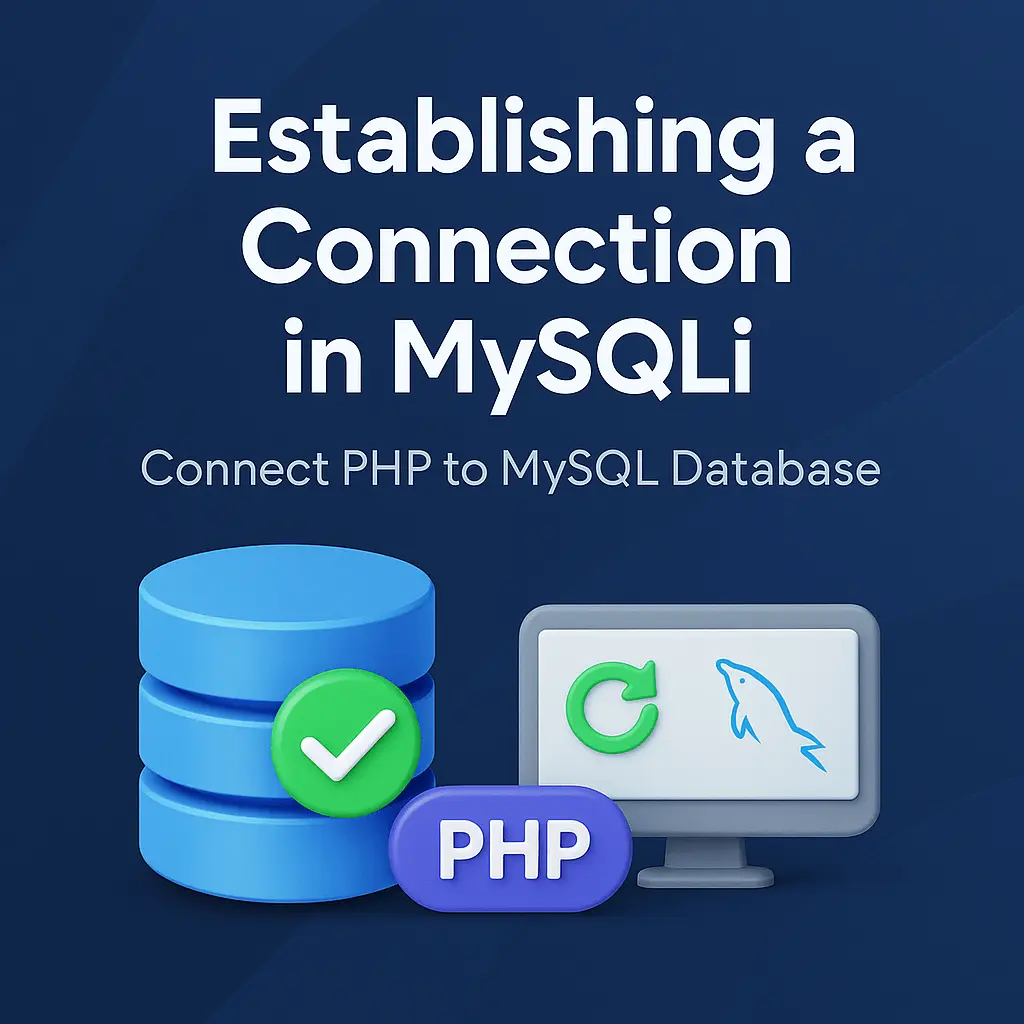Establishing a connection using MySQLi is straightforward, but understanding the details of this process is crucial for developing secure and efficient web applications.
In this article, we will delve into the detailed steps required to establish a connection using MySQLi in PHP. We will cover both object-oriented and procedural approaches, as MySQLi supports both. Additionally, we will discuss error handling and best practices to ensure a robust connection setup.
Prerequisites
Before we begin, ensure you have the following:
A web server with PHP installed (such as Apache or Nginx).
MySQL server installed and running.
Basic knowledge of PHP and MySQL.
Step-by-Step Guide to Establishing a MySQLi Connection
1. Create a Configuration File
It’s a good practice to store database credentials in a separate configuration file. This keeps your main PHP files clean and makes it easier to manage credentials. Create a file named config.php and include the following code:
<?php
// Database configuration
define('DB_SERVER', 'localhost');
define('DB_USERNAME', 'your_username');
define('DB_PASSWORD', 'your_password');
define('DB_NAME', 'your_database');
?>
Replace your_username, your_password, and your_database with your actual database username, password, and database name.
2. Establishing a Connection Using Object-Oriented MySQLi
The object-oriented approach is more commonly used due to its clear structure and ease of use.
Step 2.1: Include the Configuration File
First, include the configuration file in your script:
<?php
require_once 'config.php';
?>
Step 2.2: Create a Connection Object
Next, create a connection object using the mysqli class:
<?php
require_once 'config.php';
// Create connection
$mysqli = new mysqli(DB_SERVER, DB_USERNAME, DB_PASSWORD, DB_NAME);
// Check connection
if ($mysqli->connect_error) {
die("Connection failed: " . $mysqli->connect_error);
}
echo "Connected successfully";
?>
Step 2.3: Handling Connection Errors
The mysqli->connect_error property checks if there is a connection error. If an error occurs, the script will terminate using die() and display an error message.
3. Establishing a Connection Using Procedural MySQLi
For those who prefer a procedural approach, MySQLi also provides functions to connect to the database.
Step 3.1: Include the Configuration File
First, include the configuration file in your script:
<?php
require_once 'config.php';
?>
Step 3.2: Establish the Connection
Use the mysqli_connect() function to establish a connection:
<?php
require_once 'config.php';
// Create connection
$conn = mysqli_connect(DB_SERVER, DB_USERNAME, DB_PASSWORD, DB_NAME);
// Check connection
if ($conn === false) {
die("ERROR: Could not connect. " . mysqli_connect_error());
}
echo "Connected successfully";
?>
4. Closing the Connection
After performing database operations, it is good practice to close the connection. In the object-oriented approach, use the close() method. In the procedural approach, use the mysqli_close() function.
Closing in Object-Oriented Approach
<?php
$mysqli->close();
?>
Closing in Procedural Approach
<?php
mysqli_close($conn);
?>
5. Error Handling and Debugging
Proper error handling is crucial to diagnose issues and secure your application. MySQLi provides several methods for error handling.
Using mysqli_connect_errno() and mysqli_connect_error()
These functions return the error code and error description respectively.
<?php
require_once 'config.php';
// Create connection
$mysqli = new mysqli(DB_SERVER, DB_USERNAME, DB_PASSWORD, DB_NAME);
// Check connection
if ($mysqli->connect_errno) {
echo "Failed to connect to MySQL: (" . $mysqli->connect_errno . ") " . $mysqli->connect_error;
}
?>
Enabling Error Reporting for Debugging
For development purposes, you might want to enable detailed error reporting. Use the following settings:
<?php
ini_set('display_errors', 1);
ini_set('display_startup_errors', 1);
error_reporting(E_ALL);
?>
6. Securing Database Connections
Using Prepared Statements
To prevent SQL injection, use prepared statements for executing SQL queries. Prepared statements separate SQL logic from data input, making it impossible for an attacker to inject malicious SQL.
Example of using prepared statements in MySQLi (Object-Oriented):
<?php
require_once 'config.php';
$mysqli = new mysqli(DB_SERVER, DB_USERNAME, DB_PASSWORD, DB_NAME);
// Check connection
if ($mysqli->connect_errno) {
die("Failed to connect to MySQL: (" . $mysqli->connect_errno . ") " . $mysqli->connect_error);
}
// Prepare an SQL statement
$stmt = $mysqli->prepare("SELECT * FROM users WHERE username = ?");
$stmt->bind_param("s", $username);
// Set the parameter and execute the statement
$username = 'test_user';
$stmt->execute();
// Get the result
$result = $stmt->get_result();
while ($row = $result->fetch_assoc()) {
echo $row['username'] . "\n";
}
// Close statement and connection
$stmt->close();
$mysqli->close();
?>
7. Using Environment Variables for Configuration
For additional security, consider using environment variables to store your database credentials. This prevents hardcoding sensitive information in your codebase.
Step 7.1: Set Environment Variables
In your server’s environment configuration file (e.g., .env), set your database credentials:
DB_SERVER=localhost
DB_USERNAME=your_username
DB_PASSWORD=your_password
DB_NAME=your_database
Step 7.2: Access Environment Variables in PHP
Use the getenv() function to access these variables in your PHP script:
<?php
// Get database credentials from environment variables
$db_server = getenv('DB_SERVER');
$db_username = getenv('DB_USERNAME');
$db_password = getenv('DB_PASSWORD');
$db_name = getenv('DB_NAME');
// Create connection
$mysqli = new mysqli($db_server, $db_username, $db_password, $db_name);
// Check connection
if ($mysqli->connect_errno) {
die("Failed to connect to MySQL: (" . $mysqli->connect_errno . ") " . $mysqli->connect_error);
}
echo "Connected successfully";
?>
Conclusion
Establishing a connection to a MySQL database using MySQLi in PHP is a fundamental skill for web developers. Whether you prefer the object-oriented or procedural approach, MySQLi offers a robust and secure way to interact with MySQL databases. Remember to handle errors gracefully and secure your database credentials. By following the steps outlined in this article, you can ensure that your database connections are both efficient and secure.






